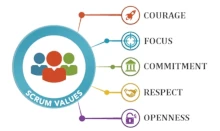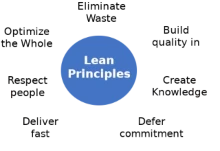The Lean-Agile Mindset is the combination of beliefs, assumptions, attitudes, and actions of leaders and practitioners who embrace the concepts of Lean Thinking and the Agile Manifesto.


Lean Thinking
In many occurrences, one will ear Lean is about waste elimination and value delivery. Nevertheless, the true value of lean is more about Continuous Improvement and Respect for People. More important than the actual improvements that individuals contribute, the true value of continuous improvement is in creating an atmosphere of continuous learning and an environment that not only accepts, but actually embraces change.
Key Principles of Lean-Agile
- Customer-Centricity: Lean-Agile places the customer at the center of every decision. Understanding their needs and preferences is the cornerstone of value-driven development.
- Continuous Improvement: The pursuit of excellence is ongoing. Teams are encouraged to reflect on their processes, seek areas of improvement, and implement changes iteratively.
- Empowering Teams: Lean-Agile advocates for self-organizing, cross-functional teams. Empowered teams are better equipped to make decisions and take ownership of their work.
- Limiting Work in Progress (WIP): By constraining the number of tasks in progress at any given time, Lean-Agile helps maintain focus and ensures that work is completed efficiently.
- Visualizing Workflow: Visualizing work with tools like Kanban boards or Scrum boards provides transparency, enabling teams to better manage their workload and identify bottlenecks.
- Pull-Based Systems: Work is pulled into the system when the team has capacity, rather than being pushed onto team members. This prevents overloading and encourages a sustainable pace of work.
Benefits of Lean-Agile
- Faster Time to Market: Lean-Agile enables teams to deliver value incrementally and iteratively, reducing time spent on lengthy planning cycles.
- Improved Quality: Continuous feedback loops and a focus on customer satisfaction result in higher-quality deliverables.
- Enhanced Collaboration: Cross-functional teams collaborate more effectively, breaking down silos and fostering a culture of shared responsibility.
- Increased Adaptability: Lean-Agile encourages responsiveness to change, allowing teams to quickly pivot in response to evolving market conditions or customer needs.
- Higher Employee Engagement: Empowered teams take ownership of their work, leading to increased job satisfaction and motivation.
Mindset Makes the Difference
Many teams in the organizations decide to take an Agile journey. They sign up to an Agile framework, adopt its processes and practices, and maybe see some improvements. But only some succeed in bringing the real benefits of Agile working ways.
The main reason is that, besides having all formal elements in place, only some work on the less tangible, but the extremely important and foundational element of any true Agile organization is the Agile mindset.
The agile mindset brings real value, the essence, things like engaged and reliable teams and delighted customers.
For example, you start to use the task board, burndown or velocity chart, and you instantly improve visibility. You introduce testing earlier in the process, and you will improve quality sooner. On the other side, the invisible part, the mindset, requires more time and skills, especially if your organization is far from where it wants to be.
People often think of visible versus invisible as doing versus being agile. So, in order to get real value from Agile frameworks such as scrum, we need to continuously work on being agile.
Organizational leadership
It's good to make sure you truly want and need the benefits of agile in the first place, but also that you're ready to accept some trade‑offs. And this applies to everyone in the organization, starting from leaders.
Psychologically‑safe environment
Throughout an agile implementation, people will need to get out of their comfort zone, change their working ways, and maybe even reassess their inner values. And to make it possible, you'll need to ensure they're operating in a psychologically‑safe environment, which means they feel secure:
- to discuss problems
- admit mistakes
- share new ideas, or
- ask for help.
Growth vs fixed mindset
What's your mindset when you think about yourself? A growth mindset is how much you believe your basic qualities, like intelligence and talent, can be changed or developed. A fixed mindset is how much you believe your basic qualities are fixed or permanent.
The Lean-Agile Growth Mindset is a belief system that encourages individuals and teams to approach work with an open, learning-oriented attitude. It emphasizes the value of continuous improvement, collaboration, and customer focus. This mindset is deeply rooted in Lean and Agile philosophies, which prioritize efficiency, responsiveness, and the delivery of value.
Mechanical Scrum vs Professional Scrum
Both Mechanical Scrum and Professional Scrum have their merits, and the choice between them depends on the specific needs and characteristics of a team or organization. Striking the right balance between structure and adaptability is crucial for Agile success >, and teams may find elements of both approaches valuable in their Agile journey.
Ultimately, the key lies in understanding the values and principles that underpin Agile methodologies and applying them in a way that best serves the team and its objectives.
Conclusion
Embracing Lean-Agile is not just a change in process; it's a cultural shift towards a more responsive, customer-centric approach to work. By adopting Lean-Agile principles and frameworks, organizations can navigate the complexities of today's business landscape with agility and resilience, ultimately achieving sustainable success in an ever-changing world.
Sources: